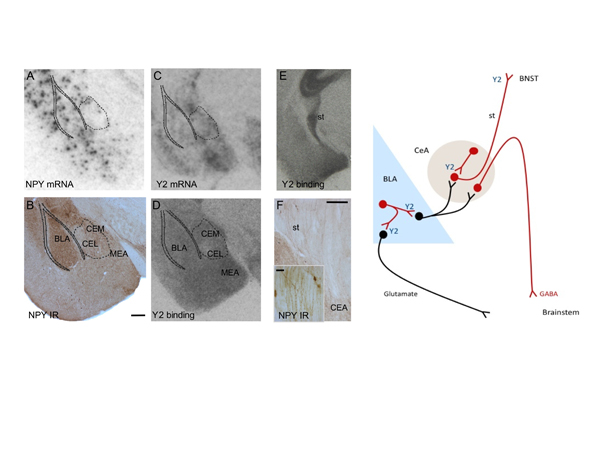Background

Fig.1. Preliminary experiments. Injection of rAAV-Cre vector into the amygdala results in profound expression of Cre mRNA at the injection site after 3 weeks (A+B) and local reduction of Y2 mRNA in a rAAV-Cre injected (C), vs. a rAAV-GFP-injected mouse (D), and in receptor binding (E) when compared to a rAAV-GFP injected animal (F).

Fig. 2. AAV-Cre induced expression of Cre mRNA is confined to the basolateral amygdala (BLA). (A) Drawing from the mouse brain atlas corresponding to sections containing the BLA. Film autoradiographs (B) and high magnification darkfield photomicrograph of a photo-emulsion-dipped section (C) showing strong but site-restricted expression of Cre mRNA after AAV-Cre injection into the BLA.

Fig. 3. Expression of Cre recombinase in the injected area results in deletion of Y2 mRNA and profound reduction in Y2 receptor binding.
(A) Film autoradiographs after in situ-hybridization showing expression of Cre mRNA in the basolateral (BLA) and central (CeA), with photoemulsion-dipped sections showing Cre positive cells (arrows) in the CeA, (B) film autoradiographs after in situ-hybridization for Cre mRNA, Y2 mRNA and after Y2 receptor binding in adjacent sections of the CeA of AAV-Cre and AAV-GVP injected Y2lox/lox mice. Note the significant reduction in Y2 mRNA compared with the more modest loss in Y2 binding, quantified in (C).

Fig. 4. Anxiety and depression-like behavior after local deletion of Y2 receptors in Y2Lox/Lox mice.

Fig.4 The anxiolytic and anti-depressant phenotype after local depletion of amygdaloid Y2 receptors may be attributed to dis-inhibition at various levels. (A) NPY mRNA and (B) NPY immunoreactivity is present in different amygdaloid nuclei as well as in (F) fibers of the stria terminalis originating from the CeA; (C) Y2 receptor mRNA and (D) Y2 receptor binding sites are present in the amygdala as well as in (E) fibers of the stria terminalis.
|